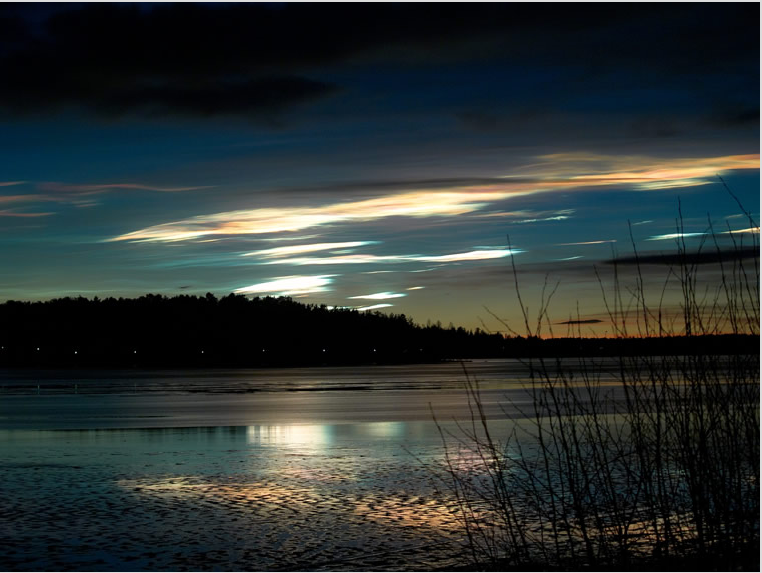Nacreous Clouds - Luleå, Northern Sweden
Nacreous Clouds - Luleå, Northern Sweden: A Spectacular Atmospheric Phenomenon
Nacreous clouds, also known as mother-of-pearl clouds, are a mesmerizing atmospheric phenomenon that occurs in the stratosphere. These clouds are so high up that they continue to catch the sun's rays even after sunset. In Luleå, Northern Sweden, on December 21st, 2006, David Legge captured a stunning image of these ethereal clouds at 2:53pm. At that time, the sun was already 7° below the horizon, having set at 1:10pm.
The image taken by David Legge showcases the extraordinary nature of nacreous clouds. The fainter clouds at the extreme left of the photograph reveal the vertical wave structure of these clouds, which is not usually apparent from the ground. This unique perspective offers a rare glimpse into the intricate patterns and formations that exist within these high-altitude clouds.
Nacreous clouds are typically found in polar regions during winter months when temperatures drop to extreme lows. These clouds form at altitudes of approximately 15 to 25 kilometers (9 to 16 miles) in the stratosphere, making them one of the highest cloud types in the atmosphere. Due to their lofty position, they are illuminated by the sun long after it has disappeared below the horizon for observers on the ground.
The stunning colors exhibited by nacreous clouds are a result of their composition and the way they interact with sunlight. These clouds consist of tiny ice crystals that refract sunlight in a unique manner. When the sun is at a low angle below the horizon, its light passes through these ice crystals, causing them to scatter the light and create a vibrant display of colors. The phenomenon is similar to what happens with rainbows, but nacreous clouds have their own distinct characteristics.
The colors seen in nacreous clouds are often described as iridescent, displaying a range of hues including pinks, purples, blues, and greens. The specific colors observed can vary depending on the size and shape of the ice crystals, as well as the angle of the sun. These mesmerizing colors add to the otherworldly beauty of nacreous clouds and make them a captivating sight for those lucky enough to witness them.
While nacreous clouds are undeniably beautiful, they are also an indicator of certain atmospheric conditions. These clouds form in the stratosphere when there is a combination of very low temperatures and high moisture content. The extreme cold allows for the formation of ice crystals, while the high moisture content provides the necessary water vapor for cloud formation. The presence of nacreous clouds is therefore an indication of a highly dynamic and complex atmospheric environment.
Studying nacreous clouds can provide valuable insights into the state of the stratosphere and its interactions with lower atmospheric layers. Scientists have been able to gather information about temperature profiles, atmospheric dynamics, and the presence of trace gases by studying these clouds. Additionally, nacreous clouds can also have an impact on ozone depletion processes in the stratosphere, further highlighting their significance in atmospheric research.
In conclusion, nacreous clouds are a remarkable natural phenomenon that grace the skies of polar regions during winter. The image captured by David Legge in Luleå, Northern Sweden, offers a breathtaking view of these high-altitude clouds and their intricate wave structure. The vibrant colors exhibited by nacreous clouds are a result of their unique composition and interaction with sunlight. Beyond their aesthetic appeal, these clouds serve as indicators of specific atmospheric conditions and provide valuable insights into the dynamics of the stratosphere. Witnessing nacreous clouds is a truly awe-inspiring experience that reminds us of the intricate beauty and complexity of our atmosphere.

Luleå, Northern Sweden 21st December '06.
David Legge took this image at 2:53pm. The sun was 7° below the horizon having set at 1:10pm.
The nacreous clouds are so high in the stratosphere that they still catch the sun's rays.
Thw fainter clouds at extreme left show the vertical wave structure of these clouds that is not usually so apparent from the ground.
Image ©2006 David Legge, shown with permission.
Note: this article has been automatically converted from the old site and may not appear as intended. You can find the original article here.
Reference Atmospheric Optics
If you use any of the definitions, information, or data presented on Atmospheric Optics, please copy the link or reference below to properly credit us as the reference source. Thank you!
-
<a href="https://atoptics.co.uk/blog/nacreous-clouds-lule-northern-sweden/">Nacreous Clouds - Luleå, Northern Sweden</a>
-
"Nacreous Clouds - Luleå, Northern Sweden". Atmospheric Optics. Accessed on November 26, 2024. https://atoptics.co.uk/blog/nacreous-clouds-lule-northern-sweden/.
-
"Nacreous Clouds - Luleå, Northern Sweden". Atmospheric Optics, https://atoptics.co.uk/blog/nacreous-clouds-lule-northern-sweden/. Accessed 26 November, 2024
-
Nacreous Clouds - Luleå, Northern Sweden. Atmospheric Optics. Retrieved from https://atoptics.co.uk/blog/nacreous-clouds-lule-northern-sweden/.